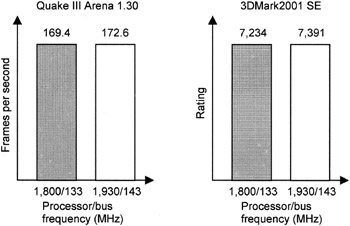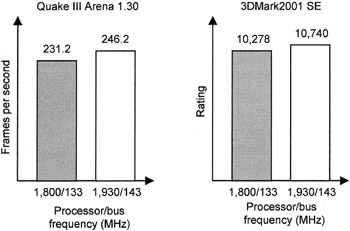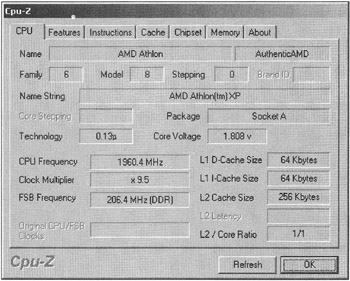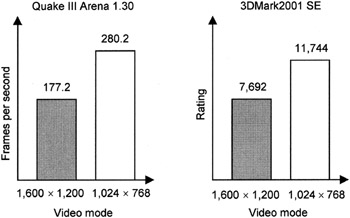Configuration of the Test System
|
| < Day Day Up > |
|
-
Motherboard — Asus A7V333 (VIA KT333, revision 1.01, BIOS version 1008)
-
Processor — AMD Athlon XP 2200+ (Thoroughbred)
-
Hard disk — IBM DTLA 305020
-
RAM — Samsung 512 MB PC2700 DDR SDRAM CL2.5
-
Video adapter — Nvidia GeForce4 Ti4600
-
Cooler — Thermaltake Volcano 7
-
Operating system — Windows XP (Nvidia Detonator 29.42)

Figure 16.1: Results of testing with a screen resolution of 1,600 × 1,200

Figure 16.2: Results of testing with a screen resolution of 1,024 × 768
The overclocking potential of the processors used proved to be rather low. However, this was not related to the motherboard used in testing. This motherboard, in contrast to the products of other manufacturers, worked not only with the latest BIOS version, but also with the initial one, which was not listed among the recommended versions. Nevertheless, the problem of incompatibility between motherboards and processors didn't lose its importance. If you decide to purchase a new processor, it is unlikely that you will have the opportunity to test a dozen of motherboards to find a suitable one. Furthermore, if the motherboard won't start, you may not have a spare processor to update the BIOS code.
In the course of testing motherboards for compatibility with processors based on the Thoroughbred core, it was revealed that most of them do not work. Those motherboards that worked prompted researchers to choose lower clock frequencies for the processor. One of the motherboards — Asus A7N266-C (Nvidia nForce415D chipset, revision 1.03), with BIOS version 1001e — chose the multiplier 5.5x (100 × 5.5 = 550 MHz, and 133 × 5.5 ≈ 733 MHz), the most suitable one from its point of view. It was impossible to update the BIOS code on this motherboard using a Thoroughbred processor because neither of the multiplier values supported by the motherboard was suitable for the processor, which meant the motherboard wouldn't start. At a new startup, there will be another transition to BIOS Setup, and you again will be prompted to choose the right frequency. You can't even reach the startup stage that allows you to boot from the diskette. The only solution in this situation is to update the BIOS code to version 1003e, using a processor based on the Palomino core. In a newer BIOS version, there were no problems with the Thoroughbred core, and the motherboard operated correctly. A similar situation existed for the Asus A7V266-E motherboard based on the VIA KT266A chipset revision 1.07 and BIOS version 1004b. Only after the BIOS was upgraded to version 1010e did it recognize processors based on the Thoroughbred core and operate without problems.
Taking into account the multiplier problem that existed for motherboards with unsuitable BIOS code, researchers decided to conduct experiments using a processor with an unlocked multiplier value. This was justified particularly for processors based on the Thoroughbred core, because this procedure is simpler for them than for their predecessors based on the Palomino core. To unlock the multiplier for processors based on the Thoroughbred core, it is necessary to restore only one bridge from the L3 group, rather than all L1 bridges as previously required (Fig. 16.3).

Figure 16.3: Unlocking the multiplier for a processor based on the Thoroughbred core
Note that during the check, the Asus A7N266-C and A7V266-E motherboards started but didn't work. As a result, it was impossible to update the BIOS, because it was impossible to set the correct multiplier value.
When the AMD Athlon XP 2200+ (Thoroughbred) processor with an unlocked multiplier was installed, the motherboard with the old BIOS version displayed the standard prompt to choose a processor frequency of 550 MHz or 733 MHz. This time, a bus frequency of 133 MHz and a multiplier of 10x were set. As a result, the motherboard successfully recognized an Athlon XP 1500+ processor, and the system booted.
Thus, for a processor with an unlocked multiplier, there appeared the possibility of changing the CPU frequency, as well as the possibility of updating the BIOS code and working at nominal frequencies. There was no need to use a second processor created with earlier technology.
As a result, researchers hypothesized that motherboards that wouldn't start with newer processors were unable to do so because they couldn't set the correct multiplier value.
A check was conducted using an Abit KX7-333 motherboard. As with previous motherboards, the same situation arose: The motherboard allowed the multiplier to be set to 5.5x instead of 13.5x. Using a smaller multiplier value and a higher frequency of the processor bus, it was possible to improve the performance of the computer.
In the newer test system with the Abit KX7-333 motherboard (BIOS version 9k), the same test conditions were reproduced. However, in this case, the RAM power supply voltage was raised to 2.75 V. As a result, it became possible to achieve a processor frequency of 2 GHz.

Figure 16.4: Parameters of an overclocked processor based on the Thoroughbred core
The CPU bus frequency and memory-bus frequency were set to 206 MHz (412 MHz DDR). The multiplier was 9.5x, and the voltage was 1.8 V.
The operating system also could be booted at a frequency of 208 MHz; however, in this mode, the system was unstable. The required level of stability for the processor used was achieved at a clock frequency of 1,930 MHz (203 MHz × 9.5). At this frequency, tests were conducted using 3DMark2001 SE and Quake III Arena at screen resolutions of 1,600 × 1,200 and 1,024 × 768.

Figure 16.5: Test results at a CPU frequency of 1,930 MHz (203 MHz × 9.5)
To conclude, motherboards compatible with previous-generation Socket A processors do not always work correctly with newer processors that comply with the same standard. However, the compatibility problem is the responsibility of motherboard manufacturers, who do not always update the BIOS code in time. Usually, the compatibility problem can be solved by unlocking the multiplier. Based on the results of experiments, it is possible to state that in most cases, a newer processor will start successfully with an older motherboard, which provides the possibility of changing the multiplier, bus frequency, and voltage levels.
|
| < Day Day Up > |
|
EAN: 2147483647
Pages: 111